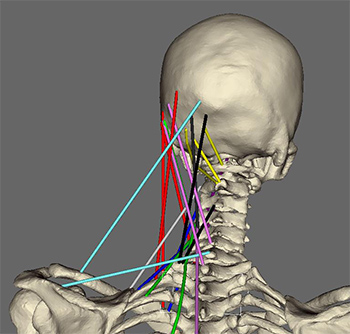The mechanics of the human neck are of eminent importance for car safety: the results of whiplash-syndroms cause in Europe alone yearly costs in the order of 1 billion €. The REGINS project "Loto" ( Linear accelerations and otolith-induced postural responses ) aims at a better understanding of the mechanics and the postural reflexes of this part of the human body. Loto is coordinated by the Department of Medical-Informatics at the Upper Austrian Research (UAR), and performed in collaboration with the University of Tübingen ( Germany ), the University of Pavia ( Italy ), and with Daimler-Chrysler.
A realistic model of the head and neck needs to incorporate the mechanics of bones and muscles, as well as the postural reflexes that control the muscle tension. Loto plans to develop such a model by building on the results of existing research. The Biomechanics Group at Physics Department in Tübingen has developed a "multi-body-dynamics" models of the human body, which has so far been applied to the mechanics of the arms, legs, and pelvis. Loto will extend this program to include the mechanics of the human head and neck. For a realistic simulation of the sensory input to the neck muscles, a finite-element (FE) program will be used which has been developed to simulate the effects of accelerations on the balance system. To avoid the high costs of proprietary FE software Loto plans to use open source software. This, combined with information campaigns to inform local SMEs about the research results, will help to make these results available to local SMEs in the areas of mechanical modeling and automotive parts.
The car producer Daimler-Chrysler collaborates in this project and will provide experimental data on the movements and forces that occur during driving a car, which will ensure that the modeling will focus on realistic conditions that occur during the driving of cars and during accidents. Additional data, which will be necessary to determine the appropriate mechanical parameters for the model, will be collected by the Computer Engineering and Systems Science Department of the University of Pavia .
A realistic biomechanical model of the human, which also covers the effects of postural reflexes, would be very helpful in improving the design of seats in cars, trains, or airplanes, notably to optimize the design of head-rests, which help to minimize head and neck injuries during accidents. It could further be used to improve seats and dampers in general since driving comfort is strongly influenced by an adequate relation between car damping and neck mechanics.







